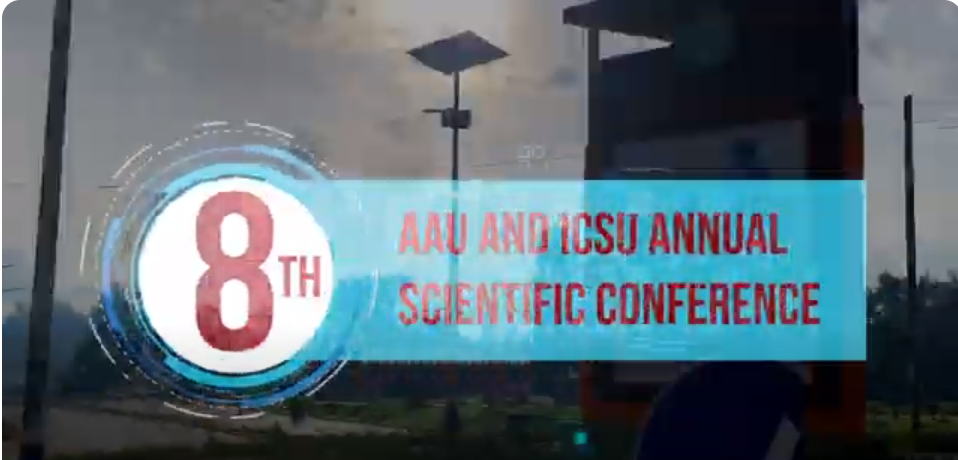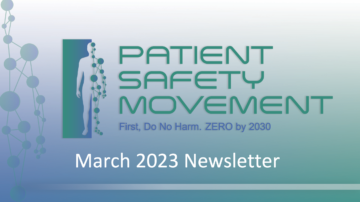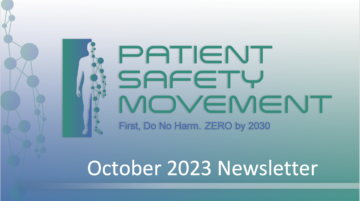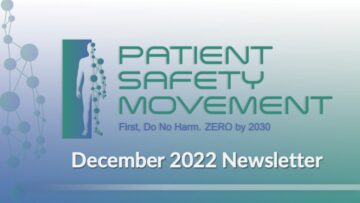“Make your commitment to ZERO… starting with culture of safety from your executive governing board down to the lowest paid employees.”
Joe Kiani, Founder
Patient Safety Movement Foundation
Letter from CEO

As we start the new year, we at the Patient Safety Movement Foundation remain committed to working with all of healthcare—hospitals, clinicians, healthcare workers, patients and patient families, scientists, the healthcare industry, safety organizations, politicians, payors, policymakers, WHO, and governments to make this year the safest ever for those receiving or working in healthcare. The safety aspect of healthcare is often compared to the airlines, a relatively safe industry. Recently, a panel blew out on a Boeing airliner at 16,000 feet. It was all over the news media. Miraculously, no passengers were injured. The cause was rapidly found; a check of all similar planes revealed several others with the loose bolts that caused this accident, and they were fixed. This should not happen again. Transparency of data leads to a rapid response and correction of the problem.
In medicine, thousands of patients sustain preventable harm, and yet we do not know the actual number, as very little is reported. The President’s Council of Advisors on Science and Technology had a subgroup looking at patient safety in the US, and among several major measures they recommended to President Biden was the reporting of medical errors that caused harm—“Transparency of Data.” If this data were made available, with the aid of AI technology reviewing medical records, would we have the same response as in the airline industry to prevent the same errors from occurring again and again?
Last month, the FDA announced the approval of gene therapy to treat patients with sickle cell disease. Sickle cell disease is a group of rare, inherited blood disorders affecting about 100,000 people in the US, mainly African Americans. It causes red blood cells to form a crescent, or “sickle,” shape that blocks blood vessels and causes severe pain and limits oxygen supply to the tissues. It is the first FDA-approved therapy utilizing a type of genome editing using CRISPR/Cas9 technology. Patients’ own blood stem cells are modified by using genome editing and injected back into the patient, where they multiply in the bone marrow and increase the production of fetal hemoglobin that increases oxygen carrying capacity and prevents sickling. This could result in a significant improvement in a disease that affects mainly a minority, and often disadvantaged, population regarding healthcare.
This month, we honor Dr. Martin Luther King Jr. with a renewed commitment to his dream. His legacy is an inspiration and a reminder of our responsibility to create a more just world.
This will be a year where great progress will be made in healthcare safety.
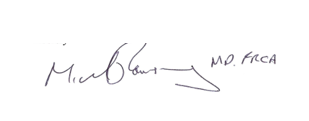
Michael A.E. Ramsay, MD, FRCA, Chief Executive Officer, PSMF
January Is National Blood Donor Month
The new year typically brings a host of personal resolutions, many of which will be forgotten in the weeks and months to come. There’s one resolution almost anyone can make and keep—and feel good about—right now: giving the gift of a blood donation.
First established in January 1969, National Blood Donor Month reminds us how much good comes from this one simple act, which normally takes just 45–60 minutes of your time. Once separated into its individual components (red blood cells, plasma, platelets), a single unit of donated blood potentially saves multiple lives, especially this time of year when bad weather, the holidays, and cold and flu season often result in fewer blood drives and critical blood shortages.
A study of more than 5,000 blood donors in 2002 found that nearly 75% of them give blood to help others. Other reasons they cited for giving blood were to feel good about themselves, support their local communities and hospitals, and “pay back” the blood supply for times when they or their loved ones needed a blood transfusion.
To find locations and times to donate blood in your community, visit the Where to Donate Blood tool offered by the Association for the Advancement of Blood & Biotherapies.
National Pharmacist Day: January 12
Over the years, pharmacists have increasingly become integrated members of the healthcare team. Beyond simply distributing drugs, they now often advise patients and healthcare providers on the selection, dosages, interactions, and side effects of prescriptions. During the COVID pandemic, their essential role as administrators of vaccinations came to the fore. Due to their direct involvement in patient care and recovery, pharmacists have a significant function in safeguarding patient safety. National Pharmacist Day on January 12 recognizes and honors the important service all pharmacists provide.
The era of modern pharmacy in the US can be traced back to William Procter Jr. (1817–1874), who dedicated his career to the science of pharmacy and wrote the first textbook on pharmacy in the US. Often regarded as the “Father of Pharmacy,” Porter founded the American Pharmaceutical Association in 1852. Here are a few other little-known facts about pharmacists in US history:
- Agatha Christie, whose mystery novels often exhibited an uncanny knowledge of poisons, served as a pharmacy dispenser during World War I.
- Pharmacists are credited with inventing many popular soft drinks, including Coca-Cola, Pepsi, Dr. Pepper, and Ginger Ale.
- Before he ran for president, Hubert Humphrey was a licensed pharmacist and worked at his father’s pharmacy.
As most of us rely on the services of pharmacists at various points throughout our lives, the month of January and National Pharmacist Day on January 12 are opportune times to recognize their work and to thank them.
Interrogating AI Fairness and Bias in Dermatology and Beyond
In the January 17 episode of the NEJM AI Grand Rounds podcast, Dr. Roxana Daneshjou shares her journey from a childhood influenced by early exposure to science to her current role as an assistant professor at Stanford. Her path included a critical shift during medical school, where her interest in computational methods and human genomics led her to pursue both an M.D. and a Ph.D. Her specialization in dermatology was driven by its visual nature and the opportunity to form long-term relationships with patients. In the podcast, Dr. Daneshjou emphasizes the importance of AI in addressing fairness and bias in dermatology, discussing her research on disparities in AI performance across diverse skin tones. The podcast also delves into broader issues of AI in healthcare, discussing the potential and challenges of integrating large language models into medical practice, and highlighting the need for interdisciplinary collaboration between clinicians and computer scientists in AI development. Dr. Daneshjou’s optimism for the future centers on the new generation of medical professionals who are increasingly concerned about fairness and equity in AI.
You can listen to the full podcast here.
Uganda Spotlight
.png?width=1120&upscale=true&name=MicrosoftTeams-image%20(11).png)
MASLD and metabolic health related
disorders as a public health safety threat
An urgent call for action
Submitted by: Arun J. Sanyal1,6,7, Sitaramaraju Yarramraju2, D. Kershenobich-Stalnikowitz3,6, Javier Davila4 and Michael Ramsay5
- Director of Stravitz-Sanyal Institute Liver Disease and Metabolic Health, Division of Gastroenterology, Hepatology and Nutrition, Department of Internal Medicine, Virginia Commonwealth University School of Medicine, Richmond, Virginia.
- Chief Executive Officer, EtCurae – Smo and Scientific Services and Avant Santé Research Center, Mexico City, Mexico.
- Department of Gastroenterology, National Institute of Medical Sciences and Nutrition “Salvador Zubirán”, Mexico City, Mexico.
- Regional President for Mexico and Governance Board Member, Patient Safety Movement Foundation, Mexico City Mexico.
- Chief Executive Officer and Governance Board Member, Patient Safety Movement Foundation, Irvine, California.
- Scientific Board Member, EtCurae – Smo and Scientific Services, Mexico City, Mexico.
- Scientific Board Member, Avant Santé Research Center, Nuevo Leon, México.
THE THREAT
Life expectancy is declining in the United States, Mexico and Latin America. Heart Disease, Type 2 Diabetes Mellitus (T2DM), Chronic Liver Disease, Chronic Kidney Disease (CKD), Stroke and Alzheimer’s disease are all in the top ten causes of mortality. These are all linked to obesity, insulin resistance and related disorders and have substantial common biology linked to metabolic dysfunction, inflammation and accelerated aging-related processes. These further increase the risk of many cancers. Similar trends for increasing morbidity and mortality from these conditions have been reported from around the world. Together, these will continue to increase the health care resource utilization and severely stress the capacity of national health systems to cope with the burden of metabolic health related disorders. Increasing disability from these disorders will have a further negatively impact workforce capacity with the potential to impact gross domestic productivity. Metabolic health related non-communicable disorders are therefore a major threat impacting the medical and financial safety of the human population globally.
KEY CHALLENGES
Some of the key challenges in tackling the threat of metabolic health related noncommunicable disorders include:
- A historical focus on individual end-organ diseases rather than a holistic approach leading to polypharmacy, duplicative care, care-fragmentation, risk of drug-drug interactions, increased cost of care.
- MASLD (metabolic dysfunction associated steatotic liver disease) is not currently even recognized by global agencies as a key element of metabolic health related disorders despite:
- Rising incidence and prevalence approaching 40% of the adult population in many nations
- Leading contributor to cirrhosis and liver cancer and liver related deaths
- Independent risk factor for development of T2DM and cardiovascular events
- Silent nature of early MASLD and other metabolic health related disorders which allows disease to go undetected and progress to advanced stages before it is identified
- Lack of awareness of MASLD and metabolic health as a holistic entity amongst the general population, health care community and policy makers
SOLUTIONS
- Inclusion of MASLD with other metabolic disorders such as T2DM, hypertension, CKD under the larger umbrella of metabolic health-related noncommunicable diseases to support integrated approaches for prevention, early detection and treatment with a view to reduce care fragmentation and costs while enhancing outcomes.
- Promote collaborative work with research organizations in public institutes that have access to large population and health care professionals in regions where these diseases go largely undetected, but present a high incidence and prevalence, such as Mexico and Latin America.
- Specific efforts to promote education of health care professionals and policy makers to support efforts focused on metabolic health in a holistic manner including all affected organ systems.
- Development of care pathways including integrated approaches for risk assessment and preventive/therapeutic strategies targeting common biology across organ systems.
Chairman’s Column

Dear Friends and Colleagues:
We are at the beginning of a new and exciting year. Not only in all our respective professional fields, but also because nearly half of the world will at some stage be facing a national election. This means that we as citizens could examine the offers of different political parties as they pertain to health in general and patient safety in particular. Whether we exercise that option is down to us as individuals, but it does give us the opportunity to do more to bring to the attention of our politicians that they have the power and opportunity to save not hundreds of lives but thousands by their interventions to support national and international initiatives in patient safety.
This year will be the first time the Global Ministerial Summit on Patient Safety will be held in the Americas after five previous Summits in London, Bonn, Tokyo, Jeddah, and Montreux. This has become the go-to meeting in patient safety, where government delegations meet with experts, patient advocates and activists, as well as health industry partners to agree on a declaration of the way forward.
The WHO and PAHO, experts, and previous host government representatives have worked with Chile to develop a fantastic agenda of relevant topics, which will be laid before ministers who will be asked to commit to their schedule of activities to reduce avoidable harm in healthcare. The plan for the Summit allows for an Expert Day followed by the Ministerial Commitment Day; this second element is not only crucial for governments to identify what they are doing to reduce avoidable harm but also to listen to other countries, and hopefully to be driven to do more!
Please find below a flyer on this year’s Summit in Santiago on April 17–18, which will be an in-person event, but for those unable to travel, a registration process will also be available to join remotely.
The Summit will be simulcast online and translated into English and Spanish (French translation will be provided for authorities on the second day). Topics to be addressed include:
- How to involve patients in the safety of care
- Information technologies, artificial intelligence, and patient safety
- National patient safety programs — what have we learned?
- National experiences in patient safety interventions in clinical challenges
- National experiences working on health workforce and patient safety
- Data implications for patient safety: information systems implemented for decision making at the national level
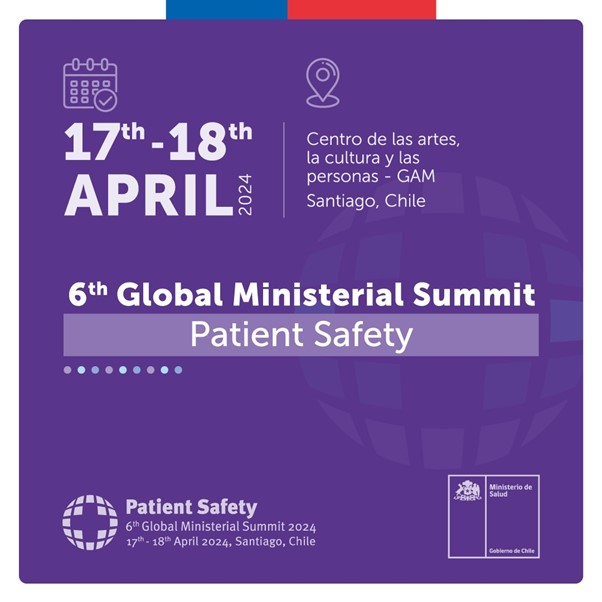
I hope that as many as possible will be able to join remotely, if not in person. Please accept my thanks for all you are doing in your own fields to reduce avoidable harm to zero, and I look forward to meeting with you again soon and definitely later in the year at our annual Summit.
Yours,
%20(1)HS.png?width=326&upscale=true&name=MicrosoftTeams-image%20(2)%20(1)HS.png)
Mike Durkin, OBE, MBBS, FRCA, FRCP, DSC
Innovation Corner*
Improving IV Line Identification
Despite technological advances in IV pumps and automated pharmacy dispensing systems, IV medication errors remain relatively unchanged. A report on the PSNET Department of Health and Human Services website cites that 48-53% of all IVs have some sort of medication error (Agency for Healthcare Research and Quality, Medication Errors & Adverse Drug Events, 2019). Despite best efforts, a direct observational study identified that during the administration of IV infusions, 58.3% of lines have a labeling error (Summa et al. “Errors associated with IV infusions in critical care”. 2012).
The International Standards Organization (ISO) at their December 6, 2023, meeting in Paris initiated discussions on creating a global IV-line labeling initiative. Comparisons were made to the current ISO 26825:2020(E): Anesthetic and respiratory equipment — User-applied labels for syringes containing drugs used during anesthesia — Colors, design, and performance. While some countries do enforce injectable medicine labeling standards, no globally recognized or US standards exist. Color differentiation is helpful, but organizations such as the US FDA and ISMP (Institute for Safe Medical Practice) strongly discourage color as the sole distinguishing factor (i.e., clinicians may be color blind; it is difficult to discern some colors in low-light conditions, etc.)
Taking that into consideration, Safen Medical has developed a library of tags for infusion therapy lines to convey a clear, intuitive message to bedside clinicians, patients, and their support system. It uses distinct shapes, colors, pre-printed text, icons, and tactile features (haptics) to communicate the contents of the infusion. Intentionally designed NOT to have technology or a software interface so it remains a simple communication system, Safen tags engage the patients and their support system alongside clinicians to provide more comprehensive care. Additionally, Safen’s system intentionally does not have alarms that may contribute to the well-documented issue of clinician “alarm fatigue.”
As we all work toward the goal of ZERO patient harm, improving IV-line identification is a very important, simple, next step of the journey.
*Patient Safety Movement Foundation does not endorse any specific commercial products, services, or companies. Information included in this section is merely to share the technologies that may improve patient safety.
In the News
- NBC News reported on the hundreds of thousands of US patients who are harmed or die each year due to diagnostic errors, with women and minorities up to 30% more likely to be misdiagnosed than white men.
- Applying principles of aerospace engineering and systems theory, a team of MIT researchers identified six systemic factors in the laboratory diagnostic test ecosystem that contribute to patient harm, as reported on MIT’s website.
- Two reports cited in Ars Technica reveal that medical errors rise and quality of care ratings drop when private equity firms purchase and operate hospitals, as they cut corners, slash services, lay off staff, take on debt, and reduce charity care.
- A BBC investigation uncovered lax enforcement of regulations in the online pharmaceutical industry that endangers patient safety, showing that 20 online pharmacies sold prescription-only drugs without adequate checks, as reported by PharmaNews Intelligence.
- UChicago Medicine nurses say “a strike is not off the table” over patient safety concerns and hold an informational picket and rally on MLK Day, according to National Nurses United.
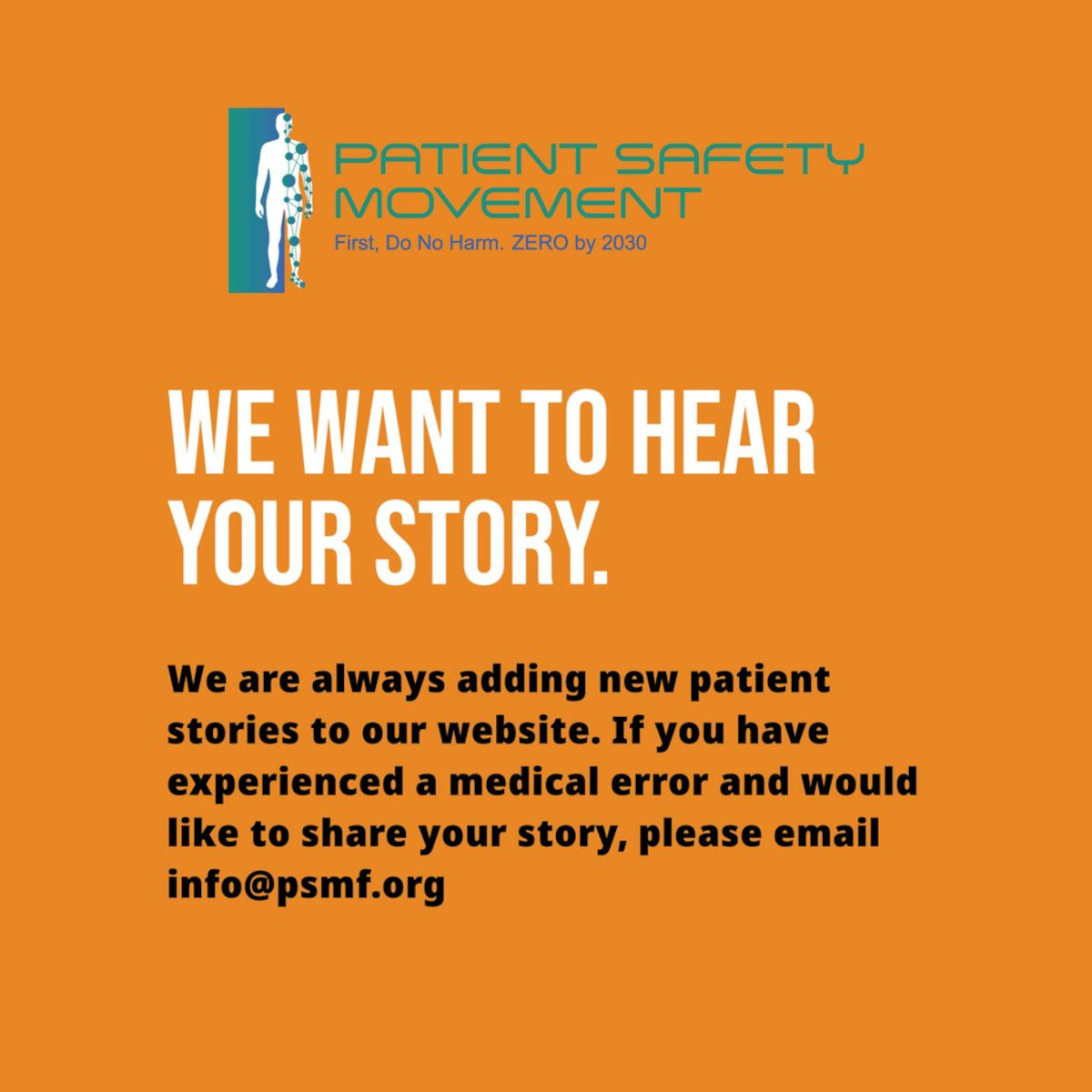
DONOR TESTIMONIALS — WHY I GIVE
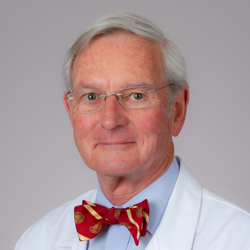
Looking back on 50 years as a cardiac anesthesiologist and critical care specialist, I am more enthusiastic today for progress in eliminating patient harm through healthcare system error than at any time in my career. Prior to donning a “long white coat” on graduation to junior doctor status, I and my fellow students took a version of the Hippocratic Oath, dating to 425 BCE, in which “I will abstain from all intentional wrong-doing and harm” was included. This is not equal to “Primum non nocere — First, do no harm” frequently ascribed to the oath but properly attributed to the English physician Thomas Sydenham in 1860, which again admonishes the physician to refrain from causing harm (and potentially withholding certain possible treatments).
Unfortunately, today, we face unacceptable patient harm incidents in our healthcare systems despite over 2,500 years of admonishment. Therefore, why my optimism today?
The key distinction, and one proselytized by the Patient Safety Movement Foundation, is to remove the onus from the paternalistic physician’s sole responsibility to regulate the healing process and its primary user, the patient. Rather, a partnership that includes all healthcare team members, which includes families, first (professional and bystander) responders, and all individuals involved personally or professionally in the patient’s care, has gained prominence and has impacted the philosophy of care, which continues to be translated into practice. As implementation gains traction, patient stories are included in our narratives, and the physician’s isolation (arrogance) is tempered and informed by multiprofessional, multidisciplinary integrated informed opinions, healthcare is likely to emerge as a safer, compassionate, healing profession that reduces patient harm, and truly, the primum non nocere admonishment is attainable. The PSMF’s goal of ZERO by 2030 becomes a reality if healthcare moves from I to an all-inclusive WE.
Philip D. Lumb, MB, BS, MD, MCCM, FCCP
Governance Board Member, Patient Safety Movement Foundation
Professor of Anesthesiology, Keck School of Medicine, University of Southern California
GOVERNANCE BOARD
Joe Kiani, MS, Founder and Immediate Past Chairman of PSMF, Founder, Chairman & CEO of Masimo
Mike Durkin, OBE, MBBS, FRCA, FRCP, DSC, Chairman of PSMF, Senior advisor on Patient Safety Policy and Leadership, Institute of Global Health Innovation, Imperial College London
Michael A.E. Ramsay, MD, FRCA, Chief Executive Officer, PSMF
Sarah Kiani, Director, Masimo Foundation for Ethics, Innovation, and Competition
Abbasseh Towfigh, MPD, Executive Director and Secretary, Ayeneh Foundation
Steven J. Barker, PhD, MD, Chief Science Officer, Masimo Corporation, Professor Emeritus of Anesthesiology, University of Arizona Health Sciences
Jannicke Mellin-Olsen, MD, DPH, Past President, World Federation of Societies of Anesthesiologists
Philip D. Lumb, MB, BS, MD, MCCM, FCCP, Professor of Anesthesiology, Keck School of Medicine, University of Southern California
Najmedin Meshkati, PhD, MS, Professor of Civil/Environmental Engineering, University of Southern California
Javier T. Davila, MD, Ambassador, PSMF in Mexico, Former Medical Director, Mexican Social Security Institute, Head of Medical Education, Research and Health Public Policy
Robin Betts, RN, CPHQ, MBA-HA, Vice Chair, PSMF, Vice President, Safety Quality & Regulatory Services, Kaiser Foundation Hospitals and Health Plan, Kaiser Permanente Northern California
Nasim Afsar, MD, MBA, MHM, Chief Health Officer at Oracle Health
Edward Kelley, PhD, Chief Global Health Officer, ApiJect Systems
David B. Mayer, MD, Executive Director, MedStar Institute for Quality and Safety
Omar Ishrak, PhD, Executive Chairman and Chairman of the Board of Directors, Medtronic, Chairman of the Board of Directors, Intel
Charlie Miceli, CPM, Treasurer, PSMF, Chief Supply Chain Officer, Network VP of University of Vermont Health Network
Vonda Vaden Bates, Patient Advocate, CEO, 10th Dot
Alicia Cole, Patient Safety Consultant
Jim Messina, BA, CEO, The Messina Group
OUR STORY
 In 2012, Joe Kiani founded the nonprofit Patient Safety Movement Foundation (PSMF) to eliminate preventable medical errors in hospitals. His team worked with patient safety experts from around the world to create Actionable Evidence-Based Practices (AEBP) that address the top challenges. The AEBP is available without charge to hospitals online.
In 2012, Joe Kiani founded the nonprofit Patient Safety Movement Foundation (PSMF) to eliminate preventable medical errors in hospitals. His team worked with patient safety experts from around the world to create Actionable Evidence-Based Practices (AEBP) that address the top challenges. The AEBP is available without charge to hospitals online.
Hospitals are encouraged to make a formal commitment to ZERO preventable deaths, and healthcare technology companies are asked to sign the Open Data Pledge to share their data so that predictive algorithms that can identify errors before they become fatal can be developed. The Foundation’s annual World Patient Safety, Science & Technology Summit brings together all stakeholders, including patients, healthcare providers, medical technology companies, government employers, and private payers. The PSMF was established through the support of the Masimo Foundation for Ethics, Innovation, and Competition in Healthcare. For more information, please visit psmf.org.

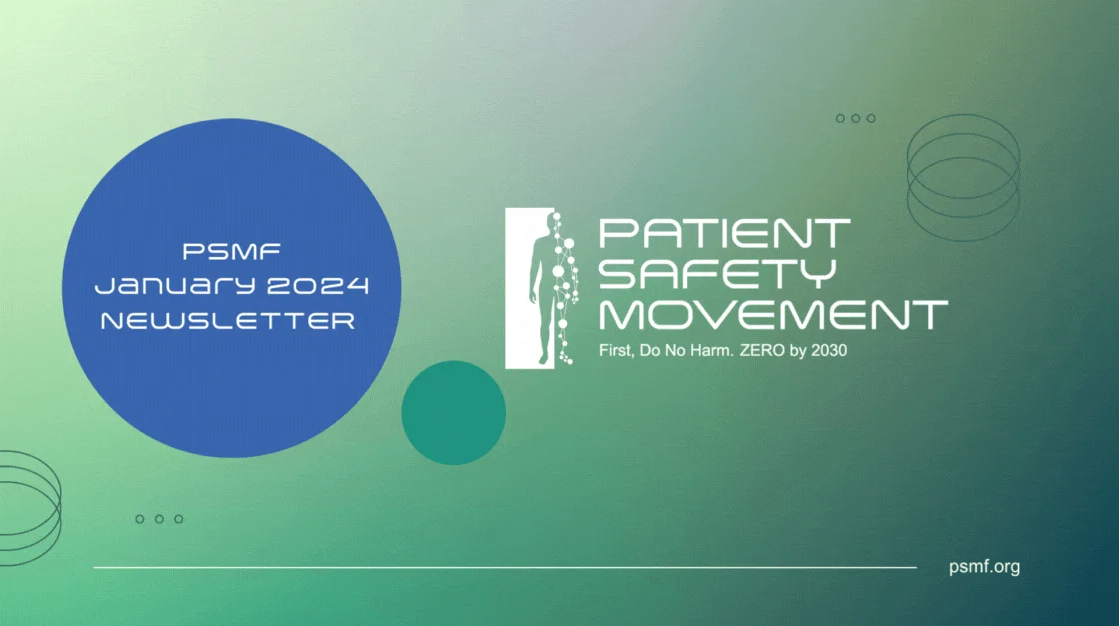
.gif?width=1120&upscale=true&name=Green%20Minimalist%20Professional%20Business%20Blog%20Banner%20(3).gif)
